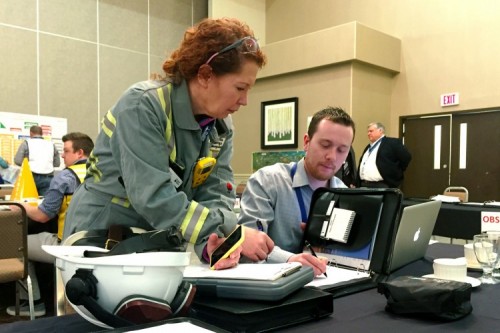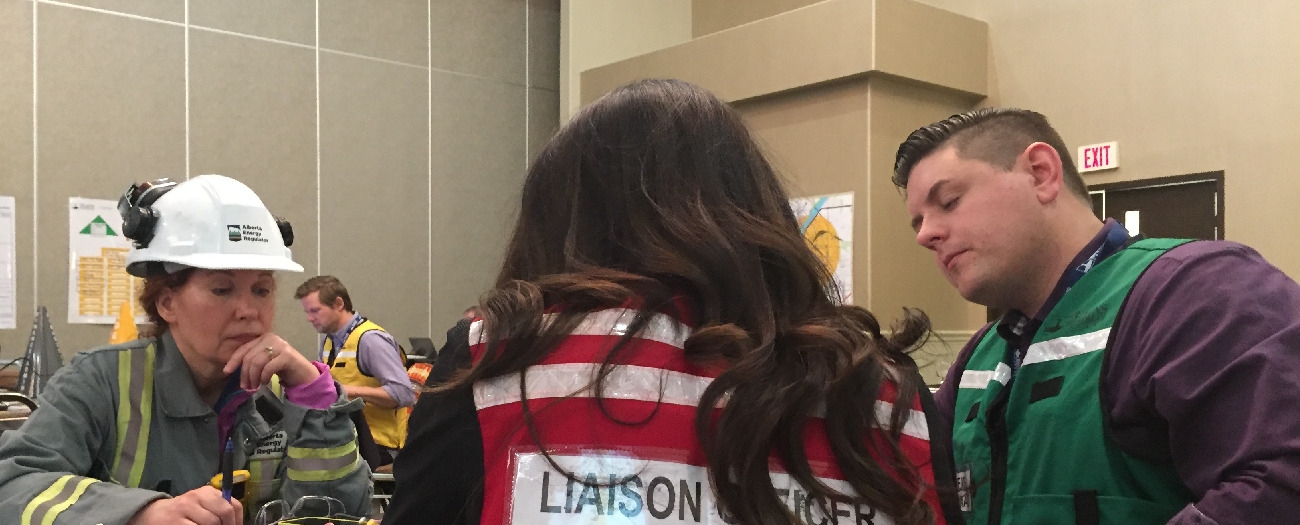Emergency response exercises make sure energy responders are ready for anything
Alberta - July 30, 2017AER requires energy operators to practise responding to emergencies so that when an incident happens, they’re ready.

“This is an exercise. Do you understand this is only an exercise?”
The words were well understood as Plains Midstream Canada practised responding to an oil and gas emergency. But despite the fact that it was only an exercise, the importance of the event was not lost on Plains staff, first responders, and Alberta Energy Regulator (AER) staff taking part.
Energy companies are required to practise how they’ll respond to an emergency in a “tabletop” exercise at least once per year, and in what’s known as a full-scale exercise once every three years. Companies must also notify the regulator that these exercises are planned before they take place.
“We require companies to practise to make sure that when an emergency happens, they respond appropriately to protect the public and environment,” said Shelley Lehmann, a field inspector out of the AER’s Edmonton Regional Office.
In a tabletop exercise, energy industry emergency responders discuss how the company would react in an emergency situation. A full-scale exercise, however, involves completing actual response activities like deploying staff to set up roadblocks and setting up an emergency response team.
Our goal during exercises is to provide a safe learning environment where it’s okay to make mistakes and questions are encouraged.
Scott Sill, senior vice president, Operations, Plains Midstream Canada
And according to Plains’ senior vice president of Operations, Scott Sill, the company practises to ensure that it’s able to implement its emergency response plan should an incident occur.
“Our goal during exercises is to provide a safe learning environment where it’s okay to make mistakes and questions are encouraged,” he said. “We then apply the lessons we learn to our program to ensure we continually improve our preparedness and response capabilities.”
While rare, emergencies happen in the energy industry. And energy companies must be prepared to respond, Lehmann said.
“AER requires energy companies to have an approved emergency response plan in place for all energy developments in the province,” she added.
Plains carried out large-scale emergency responses in 2011 and 2012 after pipeline failures tested every aspect of its emergency response plans. But despite the company’s expertise at handling major incidents, it continues to practise.
“We consider every training exercise as an opportunity to expose our response team to unique emergency scenarios and practise different roles within the Incident Command System,” Sill said.
The exercise was simulated to mimic a possible incident and involved a worker injury due to a leak from a natural gas liquids storage tank known as a bullet, Sill said.
Because of the complexity of the incident, more than 50 Plains staff, first responders from the City of Fort Saskatchewan, the City of Edmonton, and Strathcona County, and staff from agencies such as the AER, Alberta Health Services, and Alberta Transportation took part. Each group plays an important role in an energy-industry emergency.
Overall, the exercise was a success, Lehmann said. It tested the company—and the AER and municipal first responders—to ensure that everyone is ready. No one expects the practice to be perfect; it helps identify areas that companies and other responders can improve.
“At the end of the day, we just want to be sure that the public and environment are protected,” Lehmann added. “And it takes practise to make sure we’re all ready.”
Ryan Bartlett, Writer


